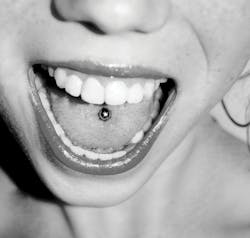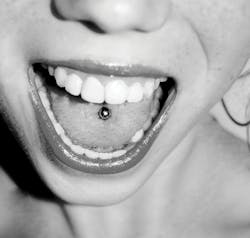Concerns with oral piercings
Although dentistry advocates against them, maintain awareness of what piercings are being used
By Staci Violante, RDH, BSDH, MSDH
Oral and body piercings are an age-old tradition that are a very common form of self-expression today. Piercings are generally found intraorally on the tongue, or periorally on the lips, cheeks, frenulum attachments, or a combination of these. Oral piercings are typically seen in young adults and teens.1 Oral piercings are divided into two types—(1) intraoral piercing, in which both ends of the jewelry are housed in the oral cavity, and (2) perioral piercing, in which one end is housed within the oral cavity and the other end penetrates the skin, for example, a lip piercing.
Although oral piercings may be fashionable, they may induce oral and systemic complications, including chipped teeth, mild or severe infections from metals or synthetic materials found in the jewelry, and gingival recession. The hardware of the jewelry is made up of stainless steel, gold, titanium, alloy, synthetic materials, or a mixture of these.
Types of oral piercings
Tongue piercing is one of the most common piercings, and the one that can encompass the greatest complications. Piercings within the oral cavity have their own risk factors and require instructional care. Patients can experience difficulties during healing. Tongue piercings are performed with a large needle that perforates the tongue and induces swelling and soreness. Positioning is essential during a tongue piercing or the result could be a possible speech impediment.
Tongue piercings can take up to four weeks to heal completely. Proper care such as daily warm salt water rinses, avoiding smoking, and mouth rinses are imperative throughout the healing process or it may not heal properly. Major risk factors with tongue piercings are chipped teeth, gingival recession, and swallowing the jewelry.
Additional tongue piercings include the venom bite, which is on the dorsal surface of the tongue and basically two piercings side-by-side that mimic a snake bite, and the snake eye, which is a horizontal piercing through the tip of the tongue using a curved barbell.
Important steps for patients to care for oral piercings
1. Use a mouthwash that is alcohol-free. The alcohol will have a burning effect and may irritate the piercing.
2. Use salt water rinses. Warm or cold salt water rinses after eating, drinking, and smoking will aid in the healing process and soothe
the pierced area.
3. Brush daily. Brushing at least three times per day will eliminate plaque and bacteria as well as food particles from accumulating and thus prevent hindering of the healing process. Patients should use a new toothbrush during the healing phase.
4. Use proper toothpaste.It is important that patients use a dentifrice free of whitening products to prevent developing a yeast infection.4
A piercing on the frenulum of the tongue, the small fold of mucous membrane extending from the floor of the mouth to the midline of the underside of the tongue, is called a tongue web. Like other oral piercings, healing time for the frenulum piercing is about four weeks.
Frenulum piercings include:
• Frowny or web piercing through the lingual frenulum—This usually cannot be seen, it heals in about four weeks but is rejected by the body easily, and it harbors risk factors such as gingival recession, enamel wear and destruction, and migration.
• Smiley piercing through the maxillary labial frenulum—This can be seen when the patient smiles. Healing time is 4 to 12 weeks but there are risk factors such as gingival recession, enamel wear and destruction, rejection, and migration. As a result of constant movement of the upper lip during speech and chewing, a lot of stress is placed on the piercing that could cause migration or rejection.
The uvula piercing is not very common, mainly because of the gag reflex. Jewelry is placed directly on the uvula which, if placed too low, can irritate the throat and move quite easily when speaking, thus causing the person to gag. This piercing may lead to snoring or other sleep-related ailments due to the jewelry obstructing the airway when a person lies down. Healing is approximately two weeks and similar to a minor sore throat.
The gingival piercing, or trans-gum piercing, is the least common of all the oral piercings. It is placed between the roots of the maxillary central incisors (Nos. 8 and 9) and through the upper jaw bone without the reference of a radiograph. This must be done by an expert on dental anatomy or maxillofacial anatomy for proper placement without sacrificing the teeth or bone. Risk factors include gingival recession, infection, and loss of teeth. This piercing is profoundly discouraged by dental professionals.
Significant risk factors to consider for oral piercings include:3
• Infection, discomfort, and inflammation
• Fractured or chipped teeth or fillings, gingival recession, tooth loss
• Allergic reaction
• Nerve damage
• Oral piercings getting in the way during dental visits
Body piercings, oral piercings, tattoos, and markings have played a key role in many cultures for thousands of years. All of these encompass various roles and meanings, such as adornments, armament, and identification. Today, they’re a form of self-expression. Although oral piercings may be appealing, they can be extremely harmful to oral health.
Routine dental visits for oral health care are instrumental in keeping oral piercings clean and secure. Proper home care is imperative in keeping the mouth, teeth, and oral piercings free from infection or harm. Dental hygienists should tell their patients to stick with a strong home-care routine that consists of brushing, rinsing, and flossing.
Most dental professionals agree oral piercings have disadvantages. “The ADA strongly advises against the practices and receiving of cosmetic intraoral/perioral piercings, and views these as invasive procedures with negative health sequelae that outweigh any potential benefits.”5
STACI VIOLANTE, RDH, BSDH, MSDH, graduated from the New York University College of Dentistry Dental Hygiene Program in 1997. She went on to complete her master’s degree at the Fones School of Dental Hygiene at the University of Bridgeport. She has been a practicing clinical dental hygienist for the past 20 years, as well as serving as clinical professor in the dental hygiene department at New York University College of Dentistry. She is currently pursuing her doctorate of health science in education.
References
1. Oral health topics. American Dental Association website. https://www.ada.org/en/member-center/oral-health-topics/oral-piercing. Updated September 18, 2017. Accessed March 27, 2018.
2. Types of oral piercings. Tattoo authority website. https://authoritytattoo.com/. Accessed March 27, 2018.
3. Levin L, Yehuda Z. Oral Piercing: Complications and side effects. Am J Dent. 20(5): 340–344. October 2007.
4. Caring for your dental oral piercings. Almost Famous Piercing website. https://www.almostfamouspiercing.com/caring-for-your-oral-piercings/. Accessed March 27, 2018.
5. Oral health topics. American Dental Association website. https://www.ada.org/en/member-center/oral-health-topics/oral-piercing. Updated September 18, 2017. Accessed March 27, 2018.

